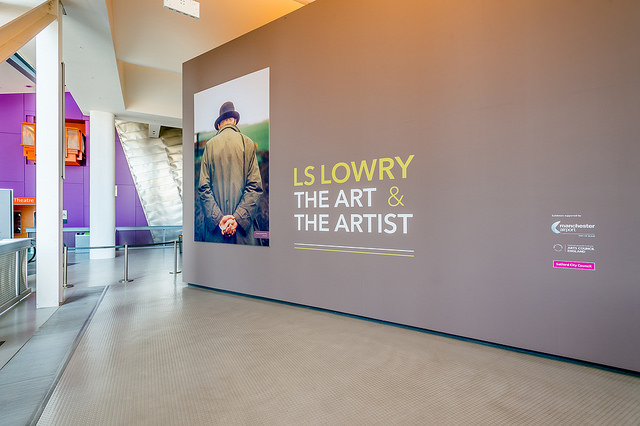There’s a painting by L.S. Lowry called Industrial Landscape: The Canal. A copy has been hanging on the wall of every house I’ve lived in since I turned 18.
In hindsight, I wonder if it’s odd for a teenager to choose a Lowry print as a coming-of-age birthday present. Maybe my peers were badgering their parents for the latest trainers or – and I’m showing my age here – the most recent Beastie Boys LP.
Nevertheless, more than 20 years since my Mum and Dad bought that picture for me, it’s still one of my most treasured possessions. To be honest, at the time it was a toss up between Industrial Landscape and Street Scene; the lure of Autumnal colours daubed on innumerable factories competing with bold reds marking out the geometric beauty of Northern terraces.
 Back then (in the early 1990s), paintings by Salford’s favourite artistic son hung in Salford Museum and Art Gallery. And they weren’t that big a deal. I went numerous times, untroubled by crowds and unrelentingly transfixed by Lowry’s canvases. Looking back, these seem like halcyon days, not unlike my early years in London when Keats’s letters and manuscripts were available to all in the poet’s former home in Hampstead. Today that would be unthinkable. As far as I can tell, Keats’s handwritten work is now locked in a British Library vault and you need special permission to see it.
Back then (in the early 1990s), paintings by Salford’s favourite artistic son hung in Salford Museum and Art Gallery. And they weren’t that big a deal. I went numerous times, untroubled by crowds and unrelentingly transfixed by Lowry’s canvases. Looking back, these seem like halcyon days, not unlike my early years in London when Keats’s letters and manuscripts were available to all in the poet’s former home in Hampstead. Today that would be unthinkable. As far as I can tell, Keats’s handwritten work is now locked in a British Library vault and you need special permission to see it.
Thank god then for The Lowry. Opened in 2000 as a brand new building in what was then an unloved part of Salford, in subsequent years this multi-purpose arts venue (encompassing theatres, a restaurant, a café and extensive gallery space) has earned its copper-bottomed reputation as a leading exhibitor of Lowry paintings. This gallery has the largest public collection of the artist’s works in the world. The world! And now, finally, Lowry’s paintings are gaining significance on the global stage. An artist once dismissed as having ‘limited ability and narrow emotional range‘ is much sought after in 2015. The last Lowry work up for auction (an image of Pendlebury Railway Station) sold for £1.6 million.
This re-evaluation of the artist continues in Salford. The Lowry has recently doubled the size of its permanent exhibition and completely re-imagined the display of the paintings and the audience’s interaction with them. Some of the works haven’t been seen in public for many years. In total there are more than 400 works in the collection, 57 of which are oil paintings.
“We’ve completely refreshed the way everything is displayed and there are new interpretations,” says Claire Stewart, curator of The Lowry Collection. “We’ve used our promenade space [usually reserved for temporary, visiting exhibitions] and it now has graphics setting the scene for Lowry and his contemporaries. For example, we have works that Lowry purchased himself, a drawing by Lucian Freud, a couple of Jacob Epstein bronzes, a charcoal drawing by Valette [a French Impressionist who was Lowry’s tutor].”
 The change is remarkable. Instead of a gaggle of paintings in one room and others crowded together in a couple of other spaces, the new exhibition space allows the visitor to enjoy and savour Lowry’s work. No more crushing into areas not fit for purpose; here the canvases are allowed room to breathe, and so are you. I found myself reassessing this remarkable artist, which is no small thing given how many times I’ve seen Lowry’s paintings and drawings.
The change is remarkable. Instead of a gaggle of paintings in one room and others crowded together in a couple of other spaces, the new exhibition space allows the visitor to enjoy and savour Lowry’s work. No more crushing into areas not fit for purpose; here the canvases are allowed room to breathe, and so are you. I found myself reassessing this remarkable artist, which is no small thing given how many times I’ve seen Lowry’s paintings and drawings.
But then Stewart has form when it comes to Northern museums and galleries. Before joining The Lowry in 2007, she worked for National Museums Liverpool. But it was the appeal of “working with a collection of just one artist” that prompted the move to Salford.
“Lowry has maintained his popularity with general visitors to The Lowry and is still a very collectable artist,” she says. “People have a great fondness for him. And there have been a sequence of good exhibitions over the last five or six years which shows that people are returning to his work.”
Perhaps the most well known of these was Lowry and the Painting of Modern Life at Tate Britain back in 2013. Long criticised for its snobbery when it comes to this artist, Tate owns 23 Lowrys (including one of my all-time favourites, The Old House) but rarely shows them. Two years before the major exhibition, Sir Ian McKellen challenged Tate to give its Lowry paintings away, saying it was “a shame verging on the iniquitous” that foreign visitors to the capital could not see them. At the same time, Noel Gallagher said of the paintings in the Tate collection: “They’re not considered Tateworthy. Or is it just because he is a Northerner?”
In the end, Tate Britain’s exhibition was a huge success and presumably a considerable money-spinner. Top price tickets were £18.50. Entry to The Lowry is free. The show also prompted an outpouring of adulation from London critics, albeit sometimes couched in grudging and patronising language (‘Anyone trying to evaluate his work has to take into account the Manchester-size chip on the shoulders of his many fans as well as the sincerity of those who can’t understand what there is to get excited about.’ – The Telegraph).
Stewart says: “In a way, Lowry’s popularity has counted against him. But if you’re looking at his work afresh, you realise how sophisticated his use of colour is and see what strong paintings they are. And, no matter what people have said, he didn’t see his work as sentimental at all.”
Lowry was irritated by people who thought his work was saccharine and annoyed by those who called him an amateur painter. In fact, he studied at the Manchester Academy of Fine Art and at Salford Royal Technical College. “If people call me a Sunday painter I’m a Sunday painter who paints every day of the week,” he said once. For the most part though, Laurence Stephen Lowry’s life has been well-documented. An unmarried rent collector who was born in Stretford but lived the better part of his life in Salford, he was, perhaps surprisingly, a lifelong supporter of the Conservative Party. He died aged 88 in 1976 just months before a retrospective exhibition opened at the Royal Academy. It broke all attendance records for a 20th century artist.
 While The Lowry has Salford Museum and Art Gallery to thank for its world-beating collection (Salford Museum began collecting the artist’s work in 1936, including buying directly from Lowry and accepting gifts of paintings from him), it doesn’t have its own acquisitions budget.
While The Lowry has Salford Museum and Art Gallery to thank for its world-beating collection (Salford Museum began collecting the artist’s work in 1936, including buying directly from Lowry and accepting gifts of paintings from him), it doesn’t have its own acquisitions budget.
“Some of the major works go for such huge prices now,” reflects Stewart. “What we have today is all down to Salford’s acquisitions policy in the past. And now we have good relationships with private collectors and other galleries. A couple of things we have on display at the moment have not been seen for 30 years because they have been in private hands.”
For the first time, some of Lowry’s drawings and paintings are being shown together. These include a preparatory drawing of Going to the Match (1953), purchased by the Professional Footballers’ Association in 2014, which is displayed alongside its world-famous namesake (itself on loan from the PFA). And there are plenty of other surprises, even for the most ardent of Lowry supporters.
For this fan at least, The Lowry has pulled a blinder. If you don’t believe me, go and see for yourself.
By Helen Nugent, Editor of Northern Soul













